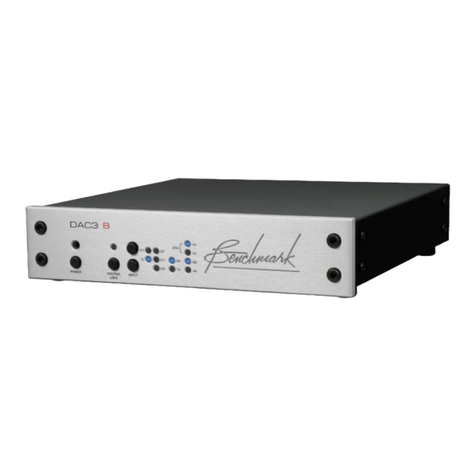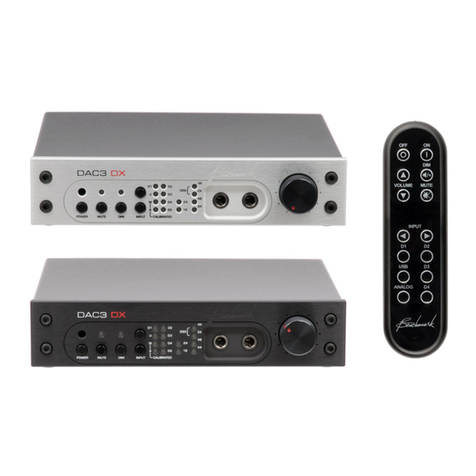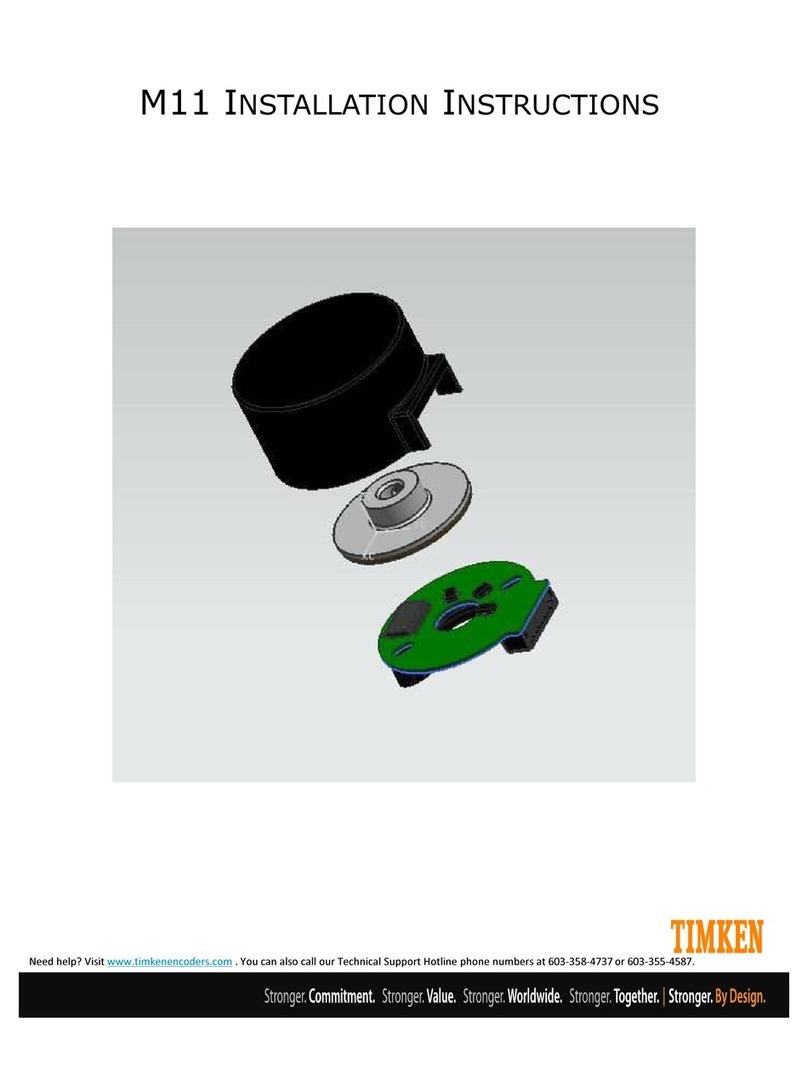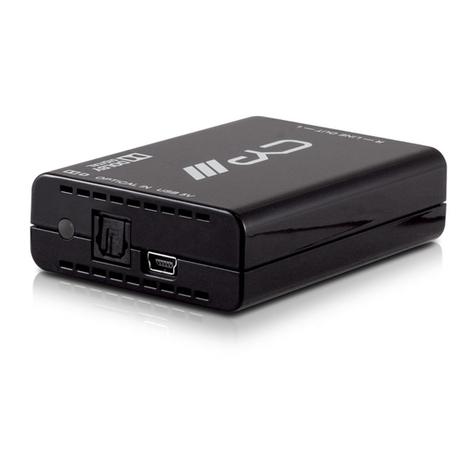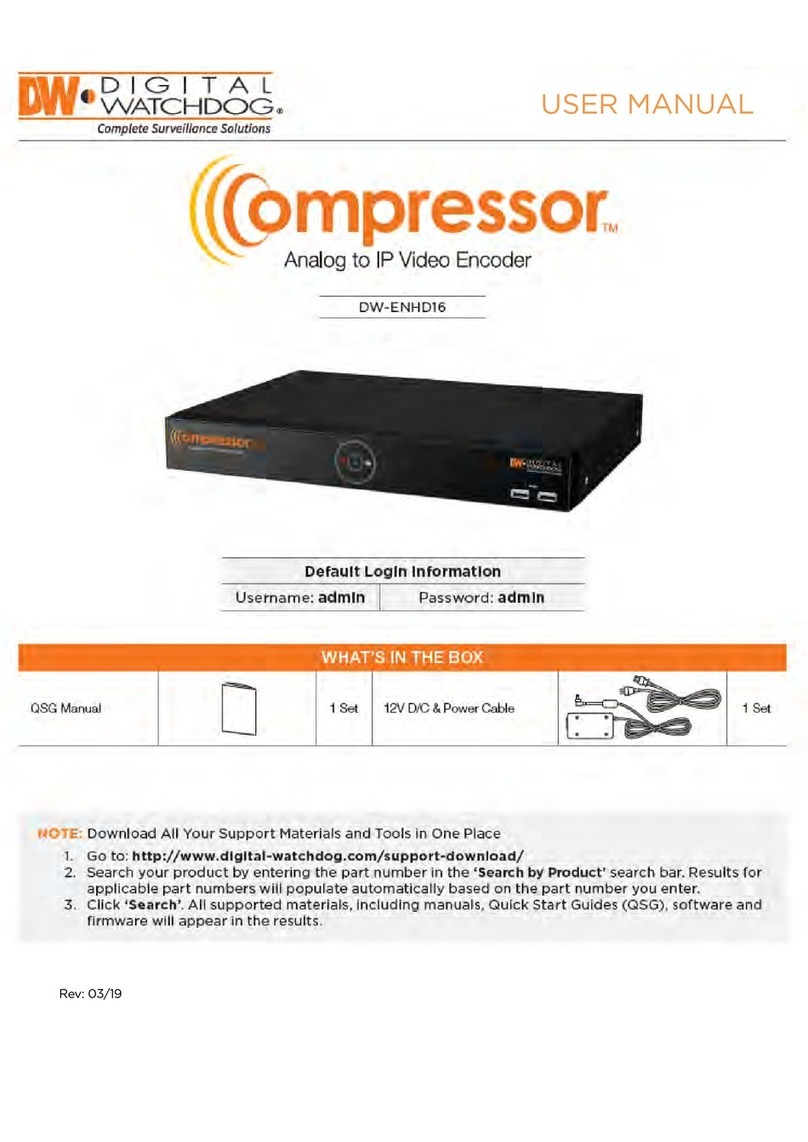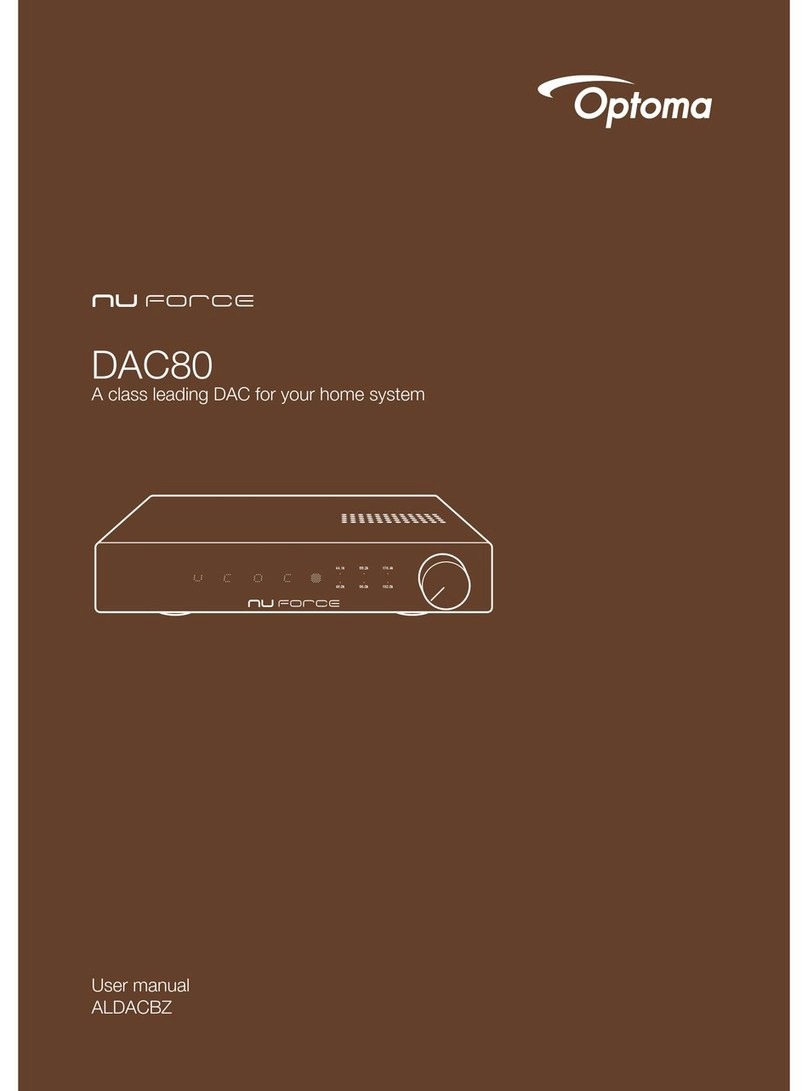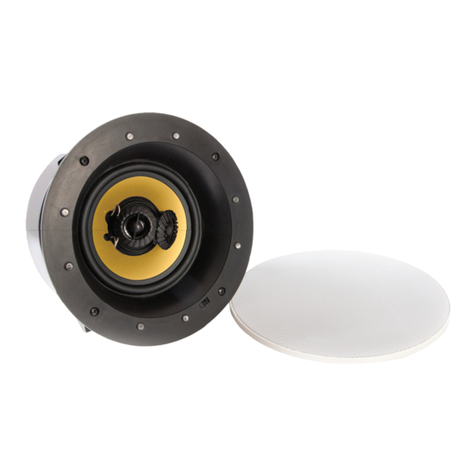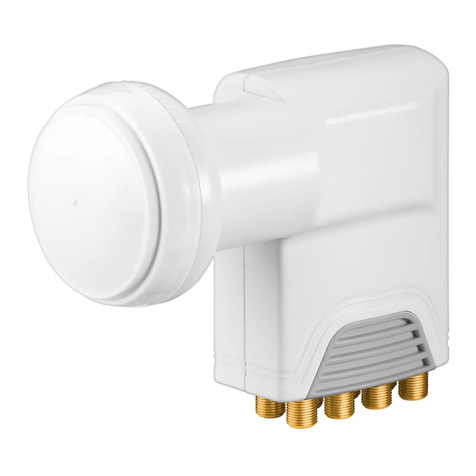Benchmark DAC1 USB User manual

Benchmark
DAC1 USB
Instruction Manual
2-Channel 24-bit 192-kHz
Audio Digital-to-Analog Converter

DAC1 USB
Instruction Manual Revision D Page 2
Safety Information
Voltage Selection
CAUTION: THE FUSE DRAWER INCLUDES
A VOLTAGE SELECTION SWITCH WITH
TWO SETTINGS: ‘110’ AND ‘220’. CHECK
TO SEE THAT IT IS PROPERLY
CONFIGURED FOR YOUR LOCATION
BEFORE CONNECTING AC POWER.
Incorrect configuration may blow fuses or
cause erratic operation.
Repairs
CAUTION: DO NOT SERVICE OR REPAIR
THIS PRODUCT UNLESS PROPERLY
QUALIFIED. ONLY A QUALIFIED
TECHNICIAN SHOULD PERFORM
REPAIRS.
Fuses
CAUTION: FOR CONTINUED FIRE
HAZARD PROTECTION ALWAYS REPLACE
THE FUSES WITH THE CORRECT SIZE
AND TYPE (0.5A 250 V SLO-BLO® 5 X 20
MM – LITTELFUSE® HXP218.500 OR
EQUIVALENT).
Modifications
CAUTION: DO NOT SUBSTITUTE PARTS
OR MAKE ANY MODIFICATIONS
WITHOUT THE WRITTEN APPROVAL OF
BENCHMARK MEDIA SYSTEMS, INC.
MODIFICATION MAY CREATE SAFETY
HAZARDS AND VOID THE WARRANTY.
NOTICE: CHANGES OR MODIFICATIONS
NOT EXPRESSLY APPROVED BY
BENCHMARK MEDIA SYSTEMS COULD
VOID THE USER'S AUTHORITY TO
OPERATE THE EQUIPMENT UNDER FCC
REGULATIONS.

DAC1 USB
Instruction Manual Revision D Page 3
Faceplate Options
The DAC1 USB is available with 3 different faceplates. The internal electronics are identical in all
versions.
Black
Silver
Black Rack-Mount

DAC1 USB
Instruction Manual Revision D Page 4
Contents
Safety Information 2
Voltage Selection 2
Repairs 2
Fuses 2
Modifications 2
Faceplate Options 3
Contents 4
Features 5
Overview 6
DAC1 Heritage 6
Applications 6
Digital Inputs 6
Advanced USB Audio Technology 6
Jitter-Immune UltraLock™ 7
HPA2™ Headphone Amplifier 7
Mute Function 7
Volume Control 7
Direct Interfacing to Power Amplifiers 7
High-Current Output Drivers 7
‘Audio-Always’ Design Philosophy 7
Error Display 8
Automatic Standby/Resume 8
Low-Noise Internal Power Supply 8
Phase-Accurate Multi-Track and 5.1 8
Automatic Digital De-Emphasis 8
Front Panel 9
Input Status Display 9
Input Selector Switch 9
Input Indication 9
Error Indication 9
Standby Mode 10
HPA2TM Stereo Headphone Jacks 10
Volume Control 10
Rear Panel 11
Input 1 - SPDIF/AES BNC 11
Input 2 – AES/EBU XLR 12
Input 3 – Optical 12
Input 4 – USB 12
Output Level Switch 13
Balanced XLR Analog Line Outputs 13
Unbalanced RCA Analog Outputs 14
Low-Impedance Passive Pads 14
Calibration Trimmers 15
AC Power-Entry Module 15
Fuse Holder 15
Rack Mounting 16
Rack Mount Coupler 16
Blank Rack Panel 16
Benchmark Technologies 17
HPA2™ Headphone Amplifier 17
UltraLock™ Clock System 18
Advanced USB Audio Technology 21
Performance Graphs 24
Frequency Response Tests 24
FFT Analysis of Idle Channel Noise 26
Multi-Unit Phase Response 27
THD+N Tests 28
Jitter Tests 33
Input Sensitivity Tests 36
Volume Control Curve 39
Specifications 40
Audio Performance 40
Group Delay (Latency) 41
Digital Audio Inputs 42
Balanced Analog Outputs 43
Unbalanced Analog Outputs 43
HPA2TM Headphone Outputs 44
Status Display 44
AC Power Requirements 44
Dimensions 45
Weight 45
Regulatory Compliance 46
FCC Notice (U.S. Only) 46
RoHS Compliant Information 46
CE Certificate of Compliance 47
Warranty Information 48
Benchmark 1 Year Warranty 48
Benchmark Extended Warranty 49
Internal Settings 50
Removing Top Cover 50
Jumpers 50

DAC1 USB
Instruction Manual Revision D Page 5
Features
yUSB, XLR balanced, BNC coaxial, and TOSLINK optical digital inputs
yCompatible with Windows Vista/XP/2000 and Mac OS X without driver installation
yJumper-selected low-impedance 10, 20, or 30 dB pads on balanced outputs
y-10 dBV unbalanced RCA analog outputs, +13.5 dBu maximum output level
yTwo HPA2™ high-current, “0-Ohm”, high-output ¼” headphone outputs
yHPA2™ gain jumpers to match gain to headphone sensitivity
yFront-panel volume control for headphone outputs
yFront-panel volume control of all analog outputs (in Variable mode)
yRear-panel Variable/Calibrated mode switch enables volume control of analog outputs
yRear-panel Variable/Calibrated mode switch includes a center mute position
yIn Calibrated mode, levels are set by 10-turn trimmers (20 dB Range, 2 dB/turn)
yXLR outputs are preset to +4dBu at 0 dBFS in Calibrated mode (20-dB Pad enabled)
yRCA outputs are preset to +2 Vrms (8.2 dBu) at 0 dBFS in Calibrated mode
yHeadphone jack 1 mutes XLR and RCA outputs (feature may be disabled)
yBenchmark’s phase-accurate UltraLock™ technology for total jitter immunity
yStatus LED’s - display input selection and error conditions
yAutomatic Standby Mode – activated after 15 seconds of loss of digital input signal
yInstant wake-up from Standby Mode - no loss of audio
yTHD+N = -107 dB, 0.00045% @ -3 dBFS input, -105 dB, 0.00056% @ 0 dBFS input
yAutomatic de-emphasis in response to consumer pre-emphasis bit (44.1, 48, 88.2, and 96 kHz)
yReliable and consistent performance under adverse operating conditions
y115 V, 230 V, 50-60 Hz international power supply with very wide operating range
yLow radiation toroidal power transformer significantly reduces hum and line related interference
yLow power consumption (8 Watts typical program, 16 Watts peak)
yMeets FCC Class B and CE emissions requirements

DAC1 USB
Instruction Manual Revision D Page 6
Overview
The DAC1 USB is a reference-quality, 2-
channel 192-kHz 24-bit digital-to-analog
audio converter featuring Benchmark’s
Advanced USB Audio technology,
UltraLock™ clock system, and HPA2™
headphone amplifier.
DAC1 Heritage
The pristine audio path of the award-winning
DAC1 has made it the Benchmark of stand-
alone D/A converters. The DAC1 USB
preserves the exact topology of this audio
path while adding some of the most
frequently requested features.
The DAC1 USB includes a very unique USB
input with bit-transparent native 96/24
capability, a programmable mute function,
programmable headphone gain range, an
automatic standby/resume feature, and a
high-current output stage designed to drive
long cables or low-impedance loads, such as
high-end power-amplifiers.
The DAC1 USB looks, sounds, and measures
the same as the DAC1. We have added
convenience and flexibility without altering
the performance.
Applications
The DAC1 USB is designed for maximum
transparency and is well suited for critical
playback in studio control rooms, mastering
rooms, and high-end audiophile applications.
Benchmark’s Advanced USB Audio interface
makes the DAC1 USB an ideal primary
output device for digital audio workstations,
desktop audio editing applications, computer-
based media playback, home media servers,
and computer-based radio broadcast systems.
The rugged and compact rack-mount option
makes the DAC1 USB an excellent choice for
location recording, broadcast facilities, and
mobile trucks.
Digital Inputs
There are four digital input connectors
(coaxial, balanced XLR, optical, and USB).
The coaxial, XLR, and optical digital inputs all
accept professional (AES) and consumer
(SPDIF) data formats at sample rates up to
192 kHz.
Advanced USB Audio Technology
The USB input is compatible with Windows
Vista/XP/2000 and Mac OS X, and does not
require driver installation or system
configuration.
Unlike all previous driverless USB audio
interfaces, Benchmark’s Advanced USB
Audio technology supports sample rates up
to 96 kHz and word lengths up to 24-bits.
The DAC1 USB is a true plug-and-play
solution, and is designed to begin playback
immediately after the unit is connected to a
USB port for the first time.

DAC1 USB
Instruction Manual Revision D Page 7
Jitter-Immune UltraLock™
The Benchmark UltraLock™ system is nearly
100% jitter-immune. The D/A conversion
clock is isolated from the input digital audio
clock in a topology that outperforms two-
stage PLL designs. In fact, no jitter-induced
artifacts can be detected using an Audio
Precision System 2 Cascade test set.
Measurement limits include detection of
artifacts as low as -140 dBFS, application of
jitter amplitudes as high as 12.75 unit
intervals (UI) and application of jitter over a
frequency range of 2 Hz to 200 kHz.
Any signal that can be decoded by the USB or
AES/EBU receivers will be reproduced without
the addition of any measurable jitter artifacts.
The AES/EBU receiver IC has been selected
for its ability to accurately recover data in the
presence of very high jitter levels.
HPA2™ Headphone Amplifier
Two ¼” headphone jacks are driven by the
HPA2™ - Benchmark’s signature high-
current, 0-Ohm headphone amplifier. The
HPA2™ is capable of delivering the full
performance of the DAC1 USB into the
difficult loading presented by headphones.
The HPA2™ maintains less than 0.0003%
THD+N under full load.
Mute Function
The left-hand headphone jack includes a
switch that mutes the XLR and RCA analog
outputs when a headphone plug is inserted.
This mute feature can be disabled with
internal jumpers.
Volume Control
The front-panel Volume Control sets the
output level of the headphone jacks. It can
also be used to control the output level of the
balanced XLR and unbalanced RCA analog
outputs. A rear-panel switch selects
Variable or Calibrated output levels. In
Variable mode the analog outputs are
controlled by the Volume Control.
Direct Interfacing to Power
Amplifiers
The DAC1 USB is designed to interface
directly to power amps and powered studio
monitors in order to provide the cleanest and
shortest path from the digital source to the
monitor output. This often results in a
substantial improvement in sound quality.
10, 20, and 30 dB pads are provided for
interfacing directly to monitors and amplifiers
that often have too much input sensitivity to
handle high-level (+29 dBu) signal levels.
High-Current Output Drivers
The DAC1 USB features new high-current
output drivers that are capable of driving
300-Ohm loads without an increase in
distortion. They are also well suited for
driving long cables or high-capacitance loads.
‘Audio-Always’ Design
Philosophy
The DAC1 USB is designed to perform
gracefully in the presence of errors and
interruptions at the digital audio inputs. A
soft mute circuit eliminates pops when a
digital signal is applied. Power management
circuitry controls the muting and resetting of
all digital circuits upon removal and
application of power. Audio is present at the
outputs only 60 ms after applying a digital
input signal and only 500 ms after applying
power to the unit.
The DAC1 USB is designed to avoid all
unnecessary mute scenarios. Muting is only
enabled upon loss of power, or when digital
transmission errors occur. The DAC1 USB
does not mute when the input data is all
zeros. Consequently, no audio is lost when
an audio transient follows full silence.
Furthermore, the DAC1 USB signal-to-noise
specifications represent the true system
performance, not just the performance of an
output mute circuit.
The DAC1 USB will operate even when
sample rate status bits are set incorrectly.

DAC1 USB
Instruction Manual Revision D Page 8
Sample rate is determined by measuring the
incoming signal. Lack of sample rate status
bits or incorrectly set status bits will not
cause loss of audio.
Error Display
When the selected digital input signal is
disconnected, incompatible, or drops out, the
Input Status Display will flash indicating a
signal error. This flashing will stop when the
error is corrected. If the error persists for
more than 15 seconds, the DAC1 USB will
enter Standby Mode.
Automatic Standby/Resume
The DAC1 USB features an automatic
standby mode that eliminates the need to
turn the converter on and off. Standby
Mode starts 15 seconds after a digital source
device is turned off, disconnected, or contains
errors that prevent D/A conversion. All LED’s
are off while in standby mode.
While in Standby Mode, the DAC1 USB
continues to monitor the selected digital input
and will immediately resume normal
operation when an error-free signal is
restored.
Low-Noise Internal Power
Supply
The internal power supply supports all
international voltages and has generous
margins for over and under voltage
conditions. It has excellent immunity to noise
on the AC line and no external AC filtering is
required.
Phase-Accurate Multi-Track and
5.1
The DAC1 is phase-accurate between
channels at all sample rates, and is phase
accurate between any combination of DAC1
and DAC1 USB converters at sample rates up
to 96 kHz. Phase-accurate multi-track and
5.1 surround systems are easily constructed
using multiple DAC1 and/or DAC1 USB
converters.
Automatic Digital De-Emphasis
Pre-emphasis was used on many early CD
recordings. It is rarely used on newer
recordings and consequently some D/A
converters omit de-emphasis. The DAC1
USB will correctly apply precise digital de-
emphasis when and if it is needed. The de-
emphasis circuit supports 44.1, 48, 88.2 and
96-kHz sample rates and is automatically
enabled in response to the pre-emphasis
status bits in consumer format digital signals.

DAC1 USB
Instruction Manual Revision D Page 9
Front Panel
Input Status Display
The DAC1 USB has three LED’s on the front
panel that indicate which digital input is
selected. These LED’s flash when an error
condition occurs. All LED’s turn off when the
DAC1 USB is in Standby Mode.
Input Selector Switch
The input selector toggle switch is located
directly to the right of the Input Status
Display.
The switch is a momentary 3-position switch
that scrolls up and down through the 4 digital
inputs in a round-robin format.
If the DAC1 USB is in Standby Mode it will
resume normal operation when the Input
Selector Switch is toggled.
Input Indication
The numbers to the left of the LED’s
correspond to the following inputs:
1. Coaxial (bottom LED)
2. XLR (middle LED)
3. Optical (top LED)
4. USB (top and bottom LED’s)
When the top and bottom LED’s are lit
simultaneously, the USB (Input 4) is selected.
Error Indication
The Input Status Display will flash when an
error occurs on the selected digital input. The
number of times the display flashes before
entering standby indicates the type of error.
If the error is not resolved within about 15
seconds, the DAC1 USB will enter Standby
Mode. The DAC1 USB will resume normal
operation when it detects a valid input signal
at the last chosen input.
Error Codes:
•No signal – 16 slow flashes – audio
muted
•Data transmission errors - 16 flashes –
audio muted
•Non-PCM – 16 flashes – audio muted
•Non-audio – 32 rapid flashes – audio
muted
•Invalid sample (v-bit) – 64 very rapid
flashes – no mute
Common causes of errors are:
•Disconnected cable
•Data drop-outs due to a bad cable
•Incompatible audio data type (AC3,
ADAT, etc.)
•Non-Audio data

DAC1 USB
Instruction Manual Revision D Page 10
Standby Mode
The DAC1 USB features an automatic
standby mode that eliminates the need to
turn the converter on and off. Standby
Mode starts 15 seconds after a digital source
device is turned off, disconnected, or contains
errors that prevent D/A conversion. All status
LED’s are off while in Standby Mode.
While in Standby Mode, the DAC1 USB
continues to monitor the selected digital input
and will immediately resume normal
operation when an error-free signal is
restored.
HPA2TM Stereo Headphone
Jacks
There are two stereo headphone jacks. The
left-hand jack is equipped with a switch that
mutes the XLR and RCA analog outputs when
a headphone plug is inserted. The right-hand
jack has no switch. This gives the user the
option of muting the analog outputs when
using headphones. Internal jumpers are
available to disable the headphone switch.
TIP: Use the left-hand jack when you
want to mute your playback system and
just listen to headphones. Use the right-
hand jack when you need to keep all
outputs active.
The dual jacks also allow two listeners to
monitor and compare notes on what is heard.
We recommend using identical headphones
because headphone sensitivities can differ
significantly. The Volume Control adjusts
the level at both jacks.
Because of the variations in headphone
sensitivity, the DAC1 USB features two gain
ranges for the headphone outputs. Our
experience with the classic DAC1 showed us
that most users cannot use the full output of
the HPA2™. These users benefit from a
reduced maximum gain. Internal jumpers
reduce the input to the HPA2™ by 10 dB and
place the Volume Control near 12 O’clock at
a comfortable listening level with most
headphones. These jumpers are factory
installed, but can be removed if a user needs
more output. Removing the jumpers
increases the gain to a level that is equal to
that of the classic DAC1.
TIP: For optimal L/R balance, the
headphone gain jumpers should be set
so that comfortable listening levels occur
when the ‘Volume Control’ is set above
the 10th detent.
Instructions for setting the headphone gain
range and headphone mute switch are
detailed in the ‘Internal Settings’ section of
this manual.
Volume Control
The front-panel Volume Control is a 41-
detent potentiometer (see ‘Volume Control
Curve’ in the ‘Performance Graphs’ section of
this manual).
The Volume Control always controls the
output level of the headphone jacks. It can
also be used to control the output levels of
the balanced XLR and unbalanced RCA analog
outputs when the rear-panel Output Level
Switch is set to Variable.
The XLR outputs have jumper-enabled pads
that can be used to optimize the gain
structure of the playback system.
TIP: For optimal L/R balance, and
minimal noise, the XLR gain jumpers
should be set so that comfortable
listening levels occur when the ‘Volume
Control’ is set above the 10th detent.
Instructions for setting the XLR pads are
detailed in the ‘Internal Settings’ section of
this manual. The DAC1 USB is shipped with
the XLR attenuation set to -20 dB.

DAC1 USB
Instruction Manual Revision D Page 11
Rear Panel
Digital Inputs
There are four digital inputs on the DAC1
USB. These inputs are selected from the
front-panel toggle switch.
The coaxial, XLR, and optical inputs can
decode AES/EBU and S/PDIF input signals in
either professional or consumer formats.
TIP: The DAC1 USB will not decode AC3
or ADAT signals. The ‘Status Display’ will
flash when AC3, ADAT, or other non-PCM
input signals are connected to the
selected digital input.
The Benchmark UltraLock™ system removes
interface jitter from all inputs. The result is
that all digital inputs have identical jitter
performance.
TIP: Internal jumpers can be used to
determine which of the four inputs is
active when the DAC1 USB is powered
up. Factory default is input 4 (USB).
Input 1 - SPDIF/AES BNC
The coaxial input uses a female BNC
connector that is securely mounted directly to
the rear panel. The input impedance is 75
Ohms. Maximum word length is 24-bits. All
sample rates between 28 and 195 kHz are
supported.
The BNC input is DC isolated, transformer
coupled, current limited, and diode protected.
The BNC body is bonded directly to the
chassis to prevent currents in the internal
ground systems. This direct bonding also
maximizes RF shielding.
TIP: Shielded 75-Ohm coaxial cable is
highly recommended for stable
performance. Do not use 50-Ohm cables.
The BNC input accepts AES/EBU or S/PDIF
digital audio formats. The BNC connector is
specified by the AES3-id and SMPTE 276M
standards for 75-Ohm 1 Vpp digital audio
signals and is commonly used in video
production facilities. IEC 609588-3 specifies
the use of an RCA type connector for 75-Ohm
0.5 Vpp consumer-format digital audio signals
(commonly known as S/PDIF). The coaxial
input on the DAC1 USB is designed to accept
either type of signal.
We have chosen to use a BNC connector
because of its superior reliability and RF
performance. The DAC1 USB comes with a
BNC-to-RCA adapter to allow easy interfacing
with consumer S/PDIF equipment.
TIP: The BNC input has a 75-Ohm
internal termination that may be

DAC1 USB
Instruction Manual Revision D Page 12
disabled by removing a jumper (JP7).
This termination is required for normal
operation, but may be removed if the
user wishes to loop a single coaxial feed
through several other pieces of
equipment.
A 75-Ohm termination must be applied at the
last device on the loop, and there should be a
combined total of less than 6 feet of cable
between the first and last receive device.
Input 2 – AES/EBU XLR
This input uses a gold-pin Neutrik™ female
XLR connector. The input is balanced and has
an input impedance of 110 Ohms. Maximum
word length is 24-bits. All sample rates
between 28 and 195 kHz are supported.
This input is DC isolated, transformer
coupled, current limited, and diode protected.
The XLR shell and pin 1 (ground) are both
directly bonded to the chassis to prevent
currents in the internal ground systems. This
direct bonding also maximizes RF shielding.
The XLR input is designed to accept standard
4 Vpp AES signals, and will work reliably with
levels as low as 300 millivolts. Receive errors
will occur (and the DAC1 USB will mute)
when the peak-to-peak input voltage is less
than about 160 millivolts at the XLR input.
TIP: Shielded 110-Ohm AES/EBU digital
audio cable is highly recommended for
stable performance. For improved
shielding, we also recommend selecting
digital cables that have the connector
shells bonded to the cable shield.
Input 3 – Optical
The optical input connector is manufactured
by Toshiba and is commonly known as a
TOSLINK connector. The TOSLINK optical
connector used on the DAC1 USB is designed
to work well at sample rates up to 192 kHz.
Maximum word length is 24-bits. All sample
rates between 28 and 195 kHz are supported.
Input 4 – USB
The USB input accepts a ‘B-type’ male USB
1.1 or USB 2.0 connector. An ‘A-B type’ USB
cable is provided with the DAC1 USB. The
USB cable connects the DAC1 USB directly to
a computer’s USB output. The USB interface
utilizes USB 1.1 protocol, and is compatible
with both USB 1.1 and USB 2.0 ports.
The USB input supports 44.1, 48, 88.2 and 96
kHz sample rates at word lengths up to 24-
bits. The USB interface acts as a ‘native’ USB
audio device and does not require the
installation of any custom drivers.
Benchmark’s Advanced USB Audio
technology achieves bit-transparent operation
without special drivers and without changing
system settings.
The Benchmark USB interface is truly a plug-
and-play solution. The DAC1 USB can begin
streaming high resolution audio bit-
transparently within seconds after being
plugged into a computer for the first time. No
software or hardware configuration is
required.
The DAC1 USB is designed, tested and
proven compatible with the following four
operating systems:
•Windows Vista
•Windows XP
•Windows 2000
•Mac OS X *
* TIP – When using OS X the system
sample rate should be set to match the
sample rate of the files being played.
Also, we do not recommend using the OS
X system volume control – set it to
100%.

DAC1 USB
Instruction Manual Revision D Page 13
Analog Outputs
The DAC1 USB has two unbalanced RCA
outputs and two balanced XLR outputs.
The DAC1 USB features new high-current
output drivers that are capable of driving
300-Ohm loads without an increase in
distortion. They are also well suited for
driving long cables or high-capacitance loads.
Note: The XLR and RCA output levels are
controlled by the Volume Control level when
the Output Level Switch is set to variable.
Otherwise the levels are set by the 10-turn
calibration trimmers located on the rear
panel.
The XLR outputs are equipped with low-
impedance passive output attenuators that
can be set at 0 dB, -10 dB, -20 dB, or -30 dB
to allow interfacing to a wide variety of audio
devices without any loss of dynamic range.
Output Level Switch
The Output Level Switch is a
three-position toggle switch
located on the rear panel. The
DAC1 USB ships with this
switch set in the Variable
position.
CAUTION: Do not set the ‘Output Level
Switch’ to ‘Calibrated’ if you are directly
driving a power amplifier or powered
speakers. The ‘Calibrated’ setting
produces an output that is near full-
volume and may damage your speakers.
Calibrated (UP) – Analog output levels are
controlled by 10-turn rear-panel trim controls.
Off (CENTER) – Analog XLR and RCA outputs
are muted; headphone outputs remain active.
Variable (DOWN) – Analog output levels are
controlled by the Volume Control.
The Output Level Switch does not affect the
operation of the headphone jacks (the
headphone outputs are never disabled and
the headphone level is always controlled from
the Volume Control).
TIP: If the DAC1 USB is being used in a
critical signal chain (such as a broadcast
facility or theater) the headphone mute
switch should be defeated using the
internal jumpers. See ‘Internal Settings’
for instructions.
Balanced XLR Analog Line
Outputs
The Left and Right balanced outputs use
Neutrik™ gold-pin male XLR jacks. The XLR
shell and pin 1 (ground) are both directly
bonded to the chassis to prevent currents in
the internal ground systems. This direct
bonding also maximizes RF shielding.
The XLR output levels may be controlled from
the front panel, or may be set to fixed levels
using the rear-panel Calibration Trimmers.
The XLR outputs have passive attenuators
that allow direct connections to a wide variety
of audio devices without a loss of dynamic
range. The 20 dB pad is usually required for
direct interfacing to power amplifiers and
powered speakers. The DAC1 USB ships
with the 20 dB pad enabled.
Industry-standard XLR wiring:
XLR pin 2 = + Audio Out
XLR pin 3 = - Audio Out
XLR pin 1 = Cable Shield
CAUTION: If the balanced XLR outputs
are wired to an unbalanced input (using
a special adapter cable), pin 3 must be
left floating. Shorting pin 3 to ground
will increase the temperature of the

DAC1 USB
Instruction Manual Revision D Page 14
output drivers, will increase power
consumption, and may cause distortion.
Unbalanced RCA Analog
Outputs
The Left and Right unbalanced outputs use
standard RCA style jacks. The
ground connections are bonded
to chassis ground at the
location where analog ground is
bonded to the chassis. This
minimizes the effects of ground
loops caused by AC currents in
the cable shield.
The RCA output levels may be controlled from
the front panel, or may be set to fixed levels
using the rear-panel Calibration Trimmers.
In Calibrated mode the RCA outputs are
factory preset to –10 dBV at -20 dBFS. This
is typical for most consumer-grade
equipment.
TIP: Mono summing with an RCA ‘Y’
cable is not recommended as this will
cause high amounts of distortion. Mono
summing with a ‘Y’ cable can be
accomplished with the use of a modified
cable by implementing a 1k Ohm series
resistor in each leg of the ‘Y’.
Note: The XLR pads do not have any effect
on the level of the RCA outputs.
The RCA output impedance is very low (30
Ohms). This makes these outputs well suited
for driving high-capacitance loads and/or
high-capacitance cables.
TIP: The RCA outputs are capable of
driving cables as long as 1360 feet (see
Table 1). But, long un-balanced cables
will generally suffer from hum problems
due to ground loops. We highly
recommend using balanced
interconnects for long runs.
Low-Impedance Passive Pads
The XLR outputs are equipped with low-
impedance passive pads that may be used to
reduce the output levels while preserving the
full dynamic range of the DAC1 USB. The
DAC1 USB ships with the 20 dB pads
enabled.
TIP: When directly driving power
amplifiers and powered speakers, use
‘Variable’ mode and start with the
factory default 20 dB pad setting. If
necessary, change the pads to achieve a
normal listening level when the ‘Volume
Control’ is near mid-rotation.
When the output pads are enabled, the
output impedance changes slightly, and the
maximum allowable cable length should be
reduced as shown in Table 1 (assuming 32
pF/foot and a maximum allowable loss of 0.1
dB at 20 kHz).
Table 1 - Cable Drive Capability
Balanced Output Drive Capability:
A
ttenuator Output Maximum Loss in dB
Setting (dB) Impedance Cable (ft) at 20 kHz
0 60 680 0.1
10 425 96 0.1
20 135 302 0.1
30 43 949 0.1
Unbalanced Output Drive Capability:
Output Maximum Loss in dB
Impedance Cable (ft) at 20 kHz
30 1360 0.1
TIP: To set the XLR outputs to typical
professional studio levels, set the pads
to 0 dB, and set the ‘Output Level Switch’
to ‘Calibrated’. If the factory settings of
the ‘Calibration Trimmers’ have not been
changed, the XLR outputs will be
calibrated to +4 dBu at -20 dBFS, and the
RCA outputs will be calibrated to -10 dBV
at -16 dBFS.

DAC1 USB
Instruction Manual Revision D Page 15
Calibration Trimmers
The Calibration Trimmers are
located to the left and right of the
Output Level Switch. They are
10-turn trimmers and are
accessible through the rear panel
using a small screwdriver.
These trimmers provide a 2 dB per rotation
adjustment with a total control range of + 9
to +29 dBu at 0 dBFS (full-scale digital
input). There are no stops at either end of
the 10-turn rotation.
CAUTION: Do not change the calibration
trimmers unless you have the ability to
accurately measure audio levels.
Factory calibration has been set so that the
output level at the balanced XLR connectors is
+4 dBu at -0 dBFS. This is exactly 20 dB
lower than a typical alignment of +4 dBu at
-20 dBFS. The lower level is appropriate for
most powered monitors.
TIP: To set the XLR outputs to typical
professional studio levels, set the pads
to 0 dB, and set the ‘Output Level Switch’
to ‘Calibrated’. If the factory settings of
the ‘Calibration Trimmers’ have not been
changed, the XLR outputs will be
calibrated to +4 dBu at -20 dBFS, and the
RCA outputs will be calibrated to -10 dBV
at -16 dBFS.
The factory-preset levels may be increased by
5 dB or decreased by 15 dB in order to
conform to other studio reference levels. This
range of levels is also well suited for direct
connection to the balanced line-level inputs
on most power amplifiers. Most professional
equipment will work well at these levels.
Note: The Calibration Trimmers have no
effect on the output levels when the Output
Level Switch is set to Variable.
AC Power-Entry Module
The AC power input uses a standard IEC type
connector. One USA-compatible power cord
is included with DAC1 USB converters
shipped to North America. IEC style power
cords in country-specific configurations are
available in your locality.
Fuse Holder
The fuse holder is built into a drawer next to
the IEC power connector. The drawer
requires two 5 x 20 mm 250 V Slo-Blo®Type
fuses. The drawer includes a voltage
selection switch with two settings: 110 and
220. The fuse rating for all voltage settings
is 0.50 Amps.
The AC input has a very wide input voltage
range and can operate over a frequency
range of 50 to 60 Hz. At 110, the DAC1
USB will operate normally over a range of 90
to 140 VAC. At 220, the DAC1 USB will
operate normally over a range of 175 to 285
VAC.
Caution: Always install the correct fuses.
Always insure that the voltage setting is
correct for your locality.

DAC1 USB
Instruction Manual Revision D Page 16
Rack Mounting
(DAC1 USB Black RM only)
The rack-mount version of the DAC1 USB is
part of Benchmark’s ½-wide System1™
product family. Each is one rack unit high
and is exactly ½ the width of a standard 19”
rack panel. The front panels on System1™
products have rack-mount holes that are
machined to conform to standard rack-mount
dimensions. Two ½-wide System1™ units
may be joined together to form a single rigid
19” panel that can be installed in any
standard 19” rack.
Either ear of a ½-wide System1™ device can
be mounted directly to a standard 19” rack.
A Rack Mount Coupler connects the other
ear to a ½-wide Blank Rack Panel or
another ½-width System1™ product
TIP: Use the rack-mount screws supplied
with the DAC1 USB (or screws with
plastic washers) to avoid scratching the
surface of the faceplate.
The Rack Mount Coupler and Blank Rack
Panel are available from Benchmark.
Call us, visit our website
(http://www.BenchmarkMedia.com), or
contact your dealer to purchase these
accessories.
Rack Mount Coupler
The Rack Mount Coupler is a machined
aluminum junction block that joins any two
½-wide System1™ devices for rack
mounting. It is also used to join a Blank
Rack Panel to a single ½-wide System1™
device.
Blank Rack Panel
The Blank Rack Panel is a ½-wide 1-RU
aluminum panel for mounting a single ½-wide
System1™ device in a standard 19” rack.
Installation requires one Rack Mount
Coupler.

DAC1 USB
Instruction Manual Revision D Page 17
Benchmark
Technologies
HPA2™ Headphone Amplifier
The DAC1 USB headphone output is driven
by Benchmark’s signature HPA2™ headphone
amplifier. This high-current, high-output
amplifier has an output impedance of near 0-
Ohms. It is designed to drive loads as low as
30 Ohms without any increase in distortion.
It also has sufficient amplitude to drive low-
sensitivity 600-Ohm headphones.
The HPA2™ includes current-limiting circuits
that fully protect against damage from short
circuits. This is important because the right
channel of a headphone amplifier will
experience a short whenever a mono phone
plug is inserted into the stereo headphone
jack. Shorts may also occur when a plug is
partially inserted.
0-Ohm Output Impedance
Most headphone amplifiers use series
resistors to maintain stability and protect
against short-circuit conditions. These
resistors are usually at least 30 Ohms, and
have a negative impact on performance. A
headphone amplifier with series resistors may
measure very well when driving resistive
loads. However, the same amplifier will
measure very poorly when driving a
headphone load. Unfortunately, most
manufacturers do not specify headphone
amplifier performance with anything other
than ideal resistive loads. Our measurements
show that headphones do not behave like
resistive loads.
Headphone Performance
In our tests we have measured substantial
distortion across resistors that are wired in
series with headphones. We conducted
measurements with a variety of headphones.
In general, distortion increases as headphone
impedance decreases. This distortion can be
eliminated with a properly designed 0-Ohm
headphone amplifier.
The performance of the HPA2™ does not
change when headphones are driven. THD+N
measurements for no-load, 30-Ohm resistive
loads, 30-Ohm headphone loads, and 600-
Ohm headphone loads are virtually identical.
The HPA2™ will substantially improve the
sound of 30 and 60-Ohm headphones. It will
make very noticeable improvements with
600-Ohm headphones.
Headphone Gain Range
Because of the variations in headphone
sensitivity, the DAC1 USB features two gain
ranges for the headphone outputs. Our
experience with the classic DAC1 showed us
that most users cannot use the full output of
the HPA2™. These users benefit from a
reduced maximum gain. Internal jumpers
reduce the input to the HPA2™ by 10 dB and
place the Volume Control near 12 O’clock at
a comfortable listening level with most
headphones. These jumpers are factory
installed, but can be removed if a user needs
more output. Removing the jumpers
increases the gain to a level that is equal to
that of the classic DAC1.
TIP: For optimal L/R balance, the
headphone gain jumpers should be set
so that comfortable listening levels occur
when the ‘Volume Control’ is set above
the 10th detent.
Instructions for setting the headphone gain
range and headphone mute switch are
detailed in the ‘Internal Settings’ section of
this manual.

DAC1 USB
Instruction Manual Revision D Page 18
UltraLock™ Clock System
Accurate 24-bit audio conversion requires a
very low-jitter conversion clock. Jitter can
very easily turn a 24-bit converter into a 16-
bit converter (or worse). There is no point in
buying a 24-bit converter if clock jitter has
not been adequately addressed.
Jitter is present on every digital audio
interface. This type of jitter is known as
‘interface jitter’ and it is present even in the
most carefully designed audio systems.
Interface jitter accumulates as digital signals
travel down a cable and from one digital
device to the next. If we measure interface
jitter in a typical system we will find that it is
10 to 10,000 times higher than the maximum
allowable level for accurate 24-bit conversion.
Fortunately, interface jitter has absolutely no
effect on the audio unless it influences the
conversion clock in an analog-to-digital
converter (A/D) or in a digital-to-analog
converter (D/A).
Many converters use a single-stage Phase
Lock Loop (PLL) circuit to derive their
conversion clocks from AES/EBU, Wordclock,
or Superclock reference signals. Single-stage
PLL circuits provide some jitter attenuation
above 5 kHz but none below 5 kHz.
Unfortunately, digital audio signals often have
their strongest jitter components at 2 kHz.
Consequently, these converters can achieve
their rated performance only when driven
from very low jitter sources and through very
short cables. It is highly unlikely that any
converter with a single-stage PLL can achieve
better than 16 bits of performance in a typical
installation. Specified performance may be
severely degraded in most installations.
Better converters usually use a two-stage PLL
circuit to filter out more of the interface jitter.
In theory, a two-stage PLL can remove
enough of the jitter to achieve accurate 24-bit
conversion (and some do). However, not all
two-stage PLL circuits are created equal.
Many two-stage PLL’s do not remove enough
of the low-frequency jitter. In addition, two-
stage PLL circuits often require several
seconds to lock to an incoming signal.
Finally, a two-stage PLL may fail to lock when
jitter is too high, or when the reference
sample frequency has drifted.
UltraLock™ converters exceed the jitter
performance of two-stage PLL converters, and
are free from the slow-lock and no-lock
problems that can plague two-stage PLL
designs. UltraLock™ converters have
extremely high immunity to interface jitter
under all operating conditions. No jitter-
induced artifacts can be detected using an
Audio Precision System 2 Cascade test set.
Measurement limits include detection of
artifacts as low as –140 dBFS, application of
jitter amplitudes as high as 12.75 UI, and
application of jitter over a frequency range of
2 Hz to 200 kHz. Any AES/EBU signal that
can be decoded by the AES/EBU receiver will
be reproduced without the addition of any
measurable jitter artifacts.
The DAC1 USB, DAC1, DAC-104, ADC1 and
the ADC-104 employ Benchmark’s
UltraLock™ technology to eliminate jitter-
induced performance problems. UltraLock™
technology isolates the conversion clock from
the digital audio interface clock. Jitter on a
D/A digital audio input, or an A/D reference
input can never have any measurable effect
on the conversion clock of an UltraLock™
converter. In an UltraLock™ converter, the
conversion clock is never phase-locked to a
reference clock. Instead the converter
oversampling-ratio is varied with extremely
high precision to achieve the proper phase
relationship to the reference clock. The clock
isolation of the UltraLock™ system insures
that interface jitter can never degrade the
quality of the audio conversion. Specified
performance is consistent and repeatable in
any installation with cables of any quality
level!
How does conversion clock jitter
degrade converter performance?
Problem #1: Jitter phase modulates the
audio signal. This modulation creates
sidebands (unwanted tones) above and below
every tone in the audio signal. Worse yet,
these sidebands are often widely separated
from the tones in the original signal.

DAC1 USB
Instruction Manual Revision D Page 19
Jitter-induced sidebands are not musical in
nature because they are not harmonically
related to the original audio. Furthermore,
these sidebands are poorly masked (easy to
hear) because they can be widely separated
above and below the frequencies of the
original audio tones. In many ways, jitter
induced distortion resembles intermodulation
distortion (IMD). Like IMD, jitter induced
distortion is much more audible than
harmonic distortion, and more audible than
THD measurements would suggest.
Jitter creates ‘new audio’ that is not
harmonically related to the original audio
signal. This ‘new audio’ is unexpected and
unwanted. It can cause a loss of imaging, and
can add a low and mid frequency ‘muddiness’
that was not in the original audio.
Jitter induced sidebands can be measured
using an FFT analyzer.
Problem #2: Jitter can severely degrade the
anti-alias filters in an oversampling converter.
This is a little known but easily measurable
effect. Most audio converters operate at high
oversampling ratios. This allows the use of
high-performance digital anti-alias filters in
place of the relatively poor performing analog
anti-alias filters. In theory, digital anti-alias
filters can have extremely sharp cutoff
characteristics, and very few negative effects
on the in-band audio signal. Digital anti-alias
filters are usually designed to achieve at least
100 dB of stop-band attenuation. But, digital
filters are designed using the mathematical
assumption that the time interval between
samples is a constant. Unfortunately, sample
clock jitter in an A/D or D/A varies the
effective time interval between samples. This
variation alters the performance of these
carefully designed filters. Small amounts of
jitter can severely degrade stop-band
performance, and can render these filters
useless for preventing aliasing.
The obvious function of a digital anti-alias
filter is the removal of audio tones that are
too high in frequency to be represented at the
selected sample rate. The not-so-obvious
function is the removal of high-frequency
signals that originate inside the converter
box, or even originate inside the converter IC.
These high-frequency signals are a result of
crosstalk between digital and analog signals,
and may have high amplitudes in a poorly
designed system. Under ideal (low jitter)
conditions, a digital anti-alias filter may
remove most of this unwanted noise before it
can alias down into lower (audio) frequencies.
These crosstalk problems may not become
obvious until jitter is present.
Stop-band attenuation can be measured very
easily by sweeping a test tone between 24
kHz and at least 200 kHz while monitoring the
output of the converter.
Put UltraLock™ converters to the
test:
We encourage our customers to perform the
above tests on UltraLock™ converters (or let
your ears be the judge). There will be
absolutely no change in performance as jitter
is added to any digital input on an
UltraLock™ converter. Try the same tests
on any converter using conventional single or
two-stage PLL circuits. Tests should be
performed with varying levels of jitter and
with varying jitter frequencies. The results will
be very enlightening. Jitter related problems
have audible (and measurable) effects on A/D
and D/A devices. Practitioners of Digital Audio
need to understand these effects.
Is it possible to eliminate all of
the effects of jitter in an entire
digital audio system?
Interface jitter will accumulate throughout
even the most carefully designed digital audio
system. Fortunately, interface jitter can
only degrade digital audio if it affects the
sampling circuit in an analog-to-digital or
digital-to-analog converter. Any attempt to
cure jitter outside of an A/D or D/A will prove
expensive and, at best, will only partially
reduce jitter-induced artifacts. Dedicated
clock signals (word clock, and super clock,
etc.) are often distributed to A/D converters
and D/A converters in an attempt to reduce
jitter. Again, these are only partial solutions
because jitter even accumulates in these
clock distribution systems. Furthermore, a

DAC1 USB
Instruction Manual Revision D Page 20
poor quality master clock generator can
degrade the performance of the entire system
(if converter performance is dependent upon
reference clock quality). Jitter free A/D and
D/A converters are the only true insurance
against the ill effects of jitter. UltraLock™
converters are jitter-immune under all
operating conditions (they will never add
audible jitter induced artifacts to an audio
signal).
What UltraLock™ converters
cannot do:
UltraLock™ converters cannot undo damage
that has already been done. If an A/D with a
jitter problem was used to create a digital
audio signal, then there is nothing that can be
done to remove the damage. Jitter-induced
sidebands are extremely complex and cannot
be removed with any existing audio device.
Therefore, it is very important to attack jitter
at both ends of the audio chain. The DAC1
USB is a great start, as it will allow accurate
assessment of various A/D converters. It is
impossible to audibly evaluate A/D
performance without a good D/A. The
consistent performance delivered by the
DAC1 USB eliminates one major variable:
jitter.
Table of contents
Other Benchmark Media Converter manuals
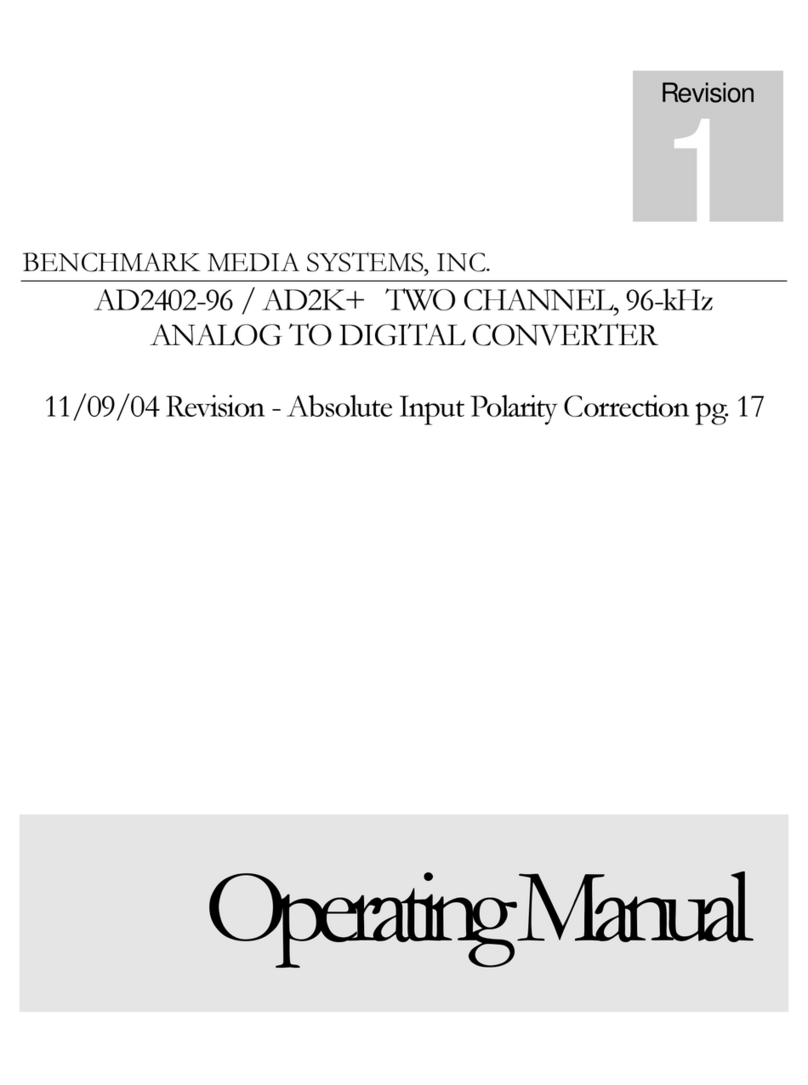
Benchmark
Benchmark AD2402-96 User manual

Benchmark
Benchmark DAC3 HGC Quick start guide

Benchmark
Benchmark ADC16 User manual
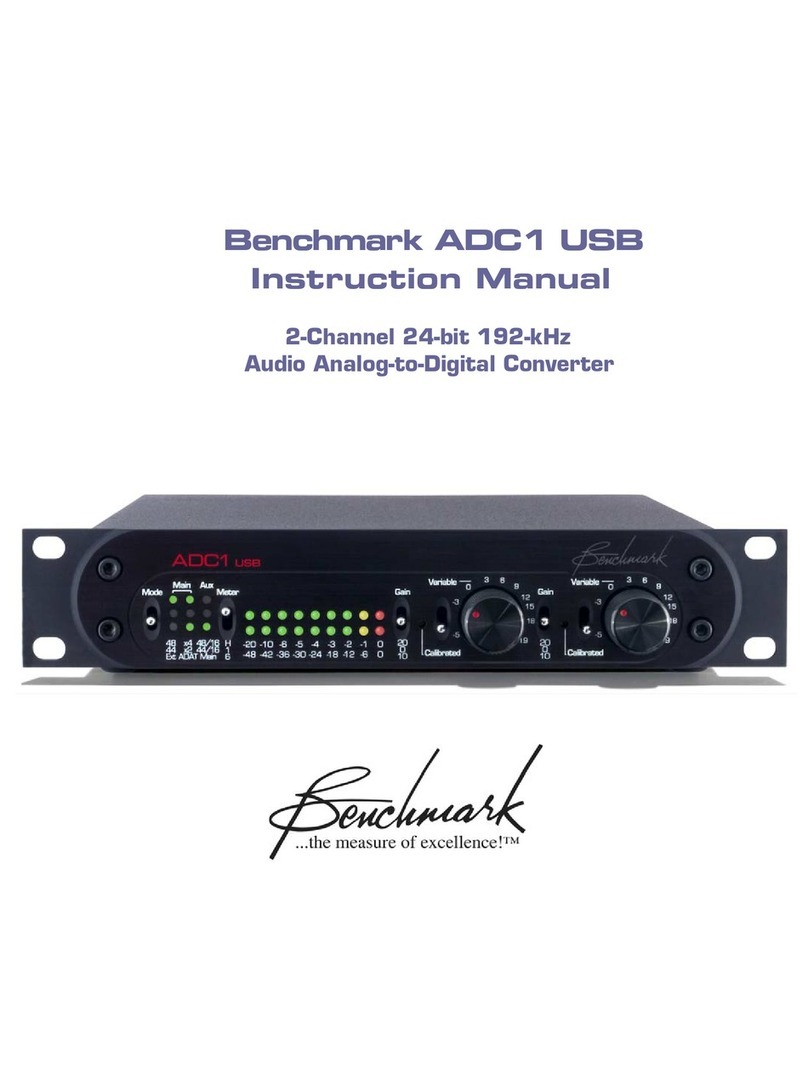
Benchmark
Benchmark ADC1 USB User manual

Benchmark
Benchmark ADC1 USB User manual
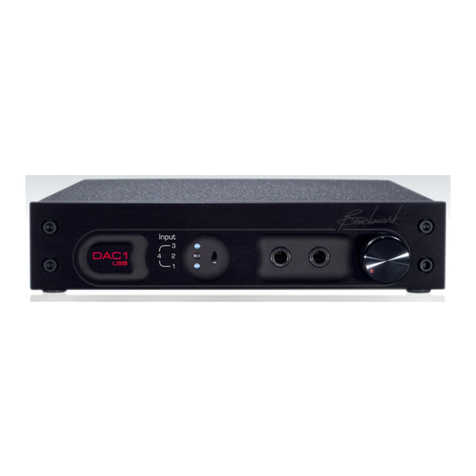
Benchmark
Benchmark DAC1 HDR User manual
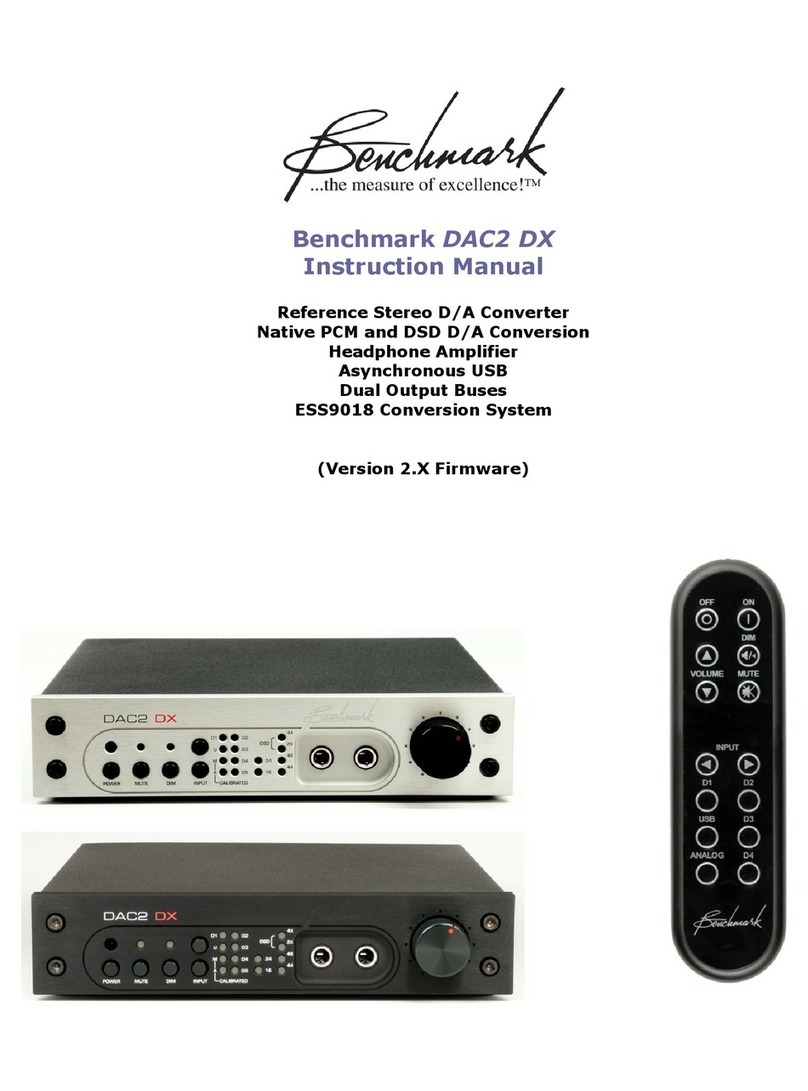
Benchmark
Benchmark DAC2 DX User manual

Benchmark
Benchmark DAC2 DX User manual
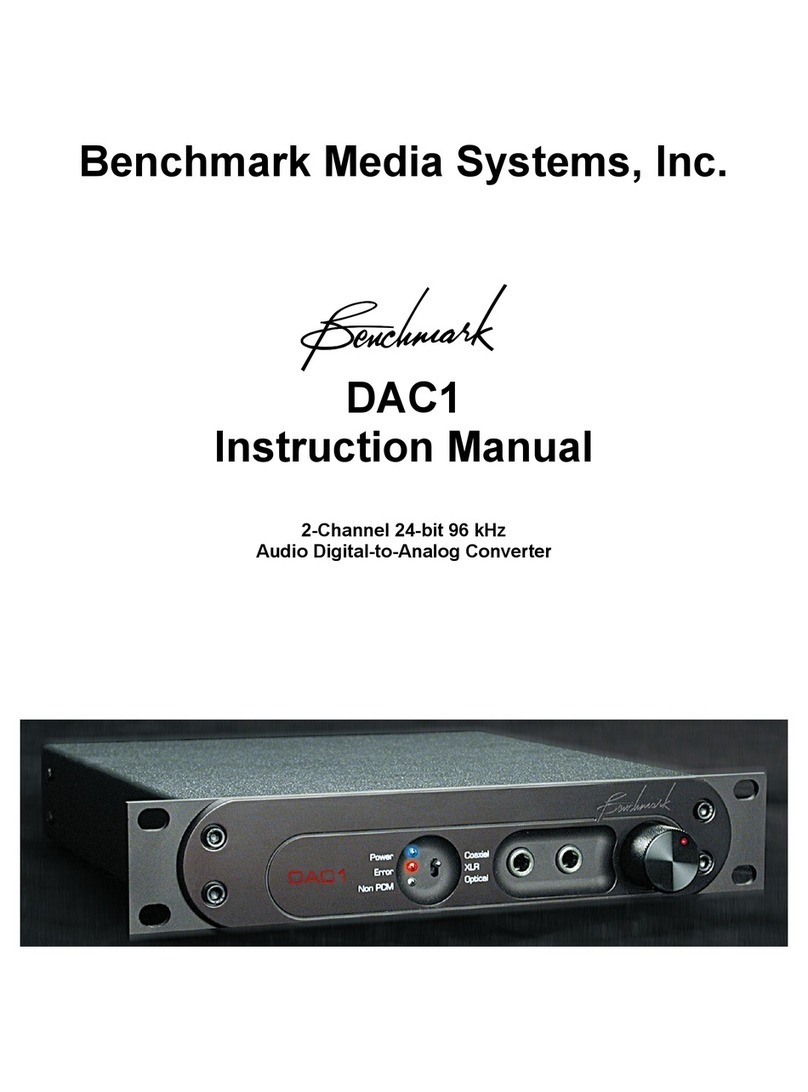
Benchmark
Benchmark DAC1 HDR User manual

Benchmark
Benchmark ADC1 USB User manual
Popular Media Converter manuals by other brands
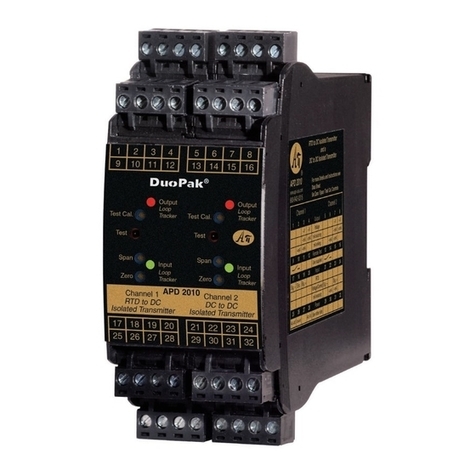
Absolute Process Instruments
Absolute Process Instruments DuoPak APD 2010 manual

Transition Networks
Transition Networks NANOMETER E-100BTX-SX-01 user guide
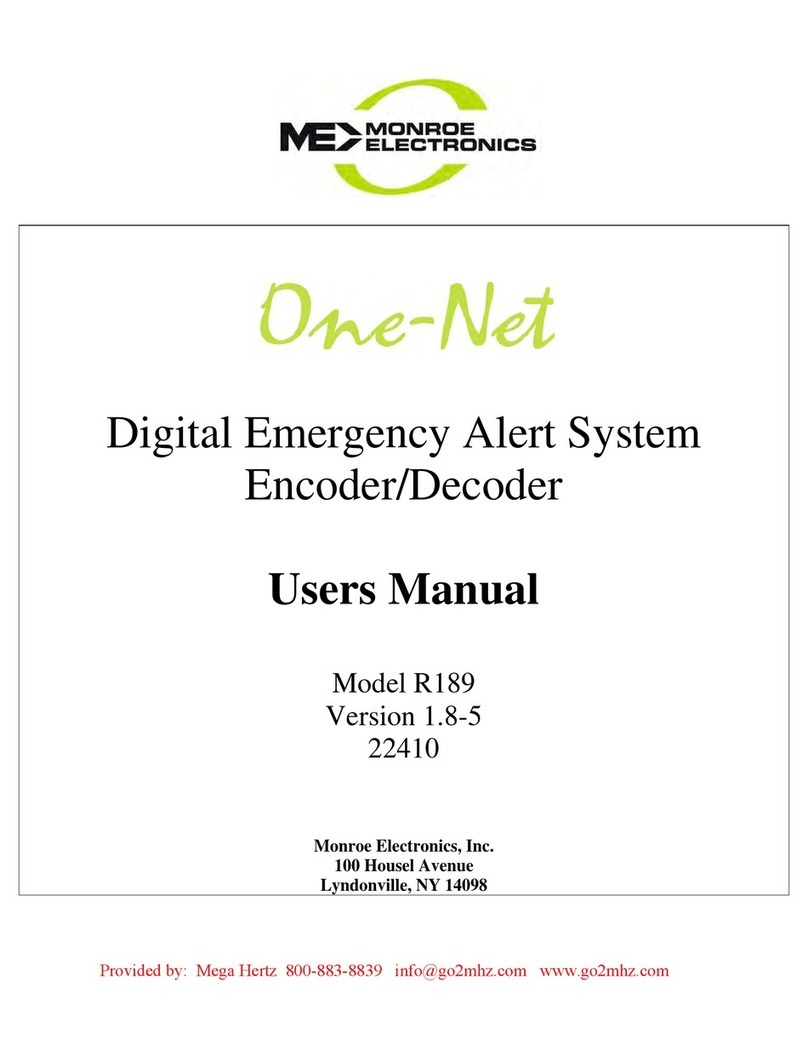
Me
Me R189 user manual
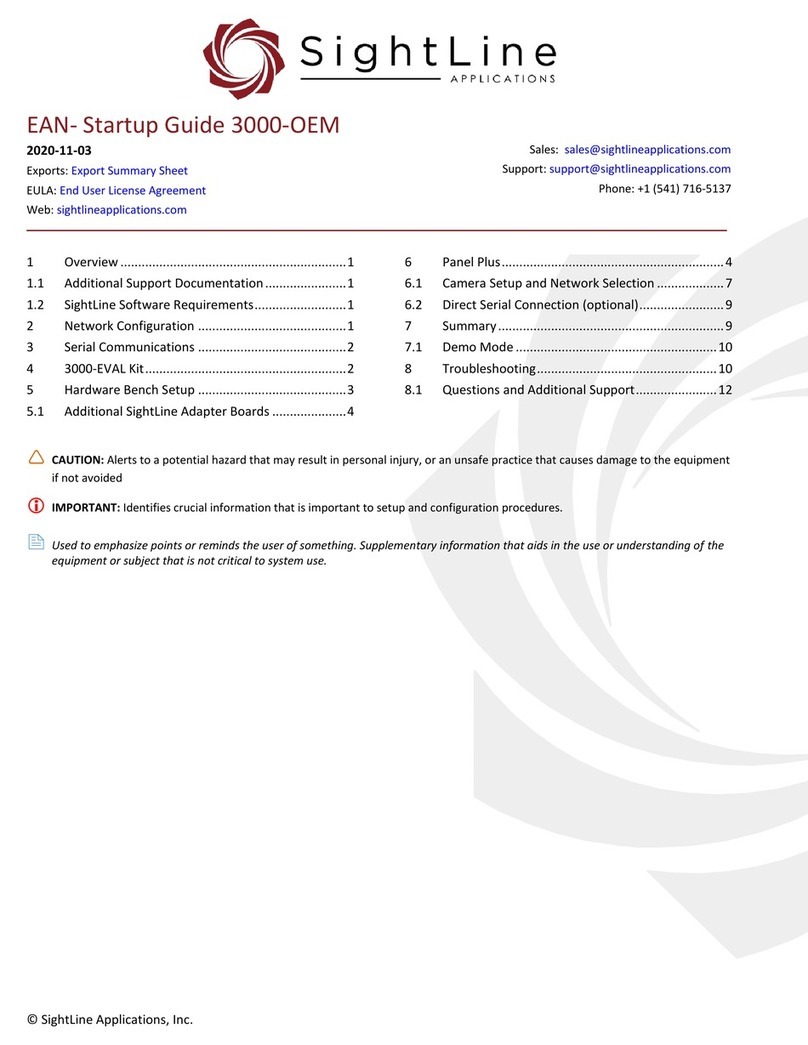
SightLine
SightLine 3000-OEM Startup guide

Vetra
Vetra SmartWye USB-311 User instructions
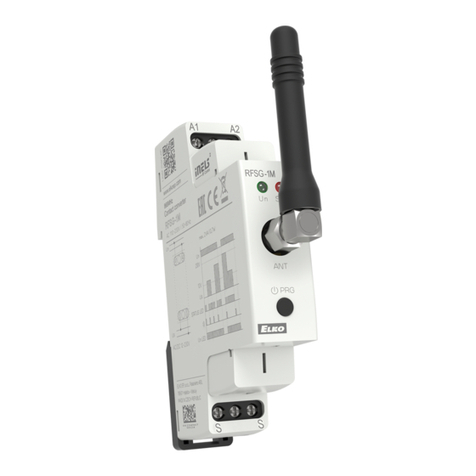
Elko
Elko inels RFSG-1M quick start guide

